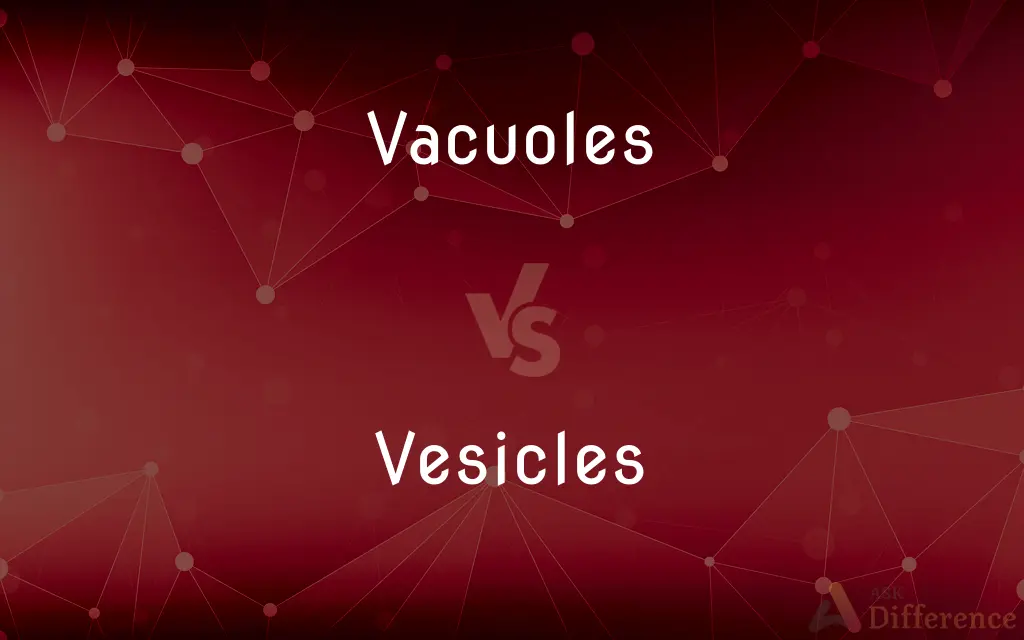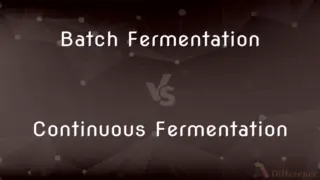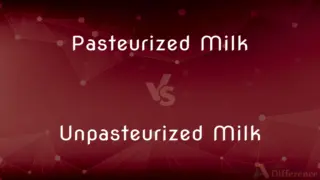Vacuoles vs. Vesicles — What's the Difference?
By Tayyaba Rehman — Published on January 12, 2024
Vacuoles are large, membrane-bound sacs in cells, mainly for storage and waste disposal. Vesicles are smaller membrane-bound sacs that transport materials within or outside cells.

Difference Between Vacuoles and Vesicles
Table of Contents
ADVERTISEMENT
Key Differences
Size and Structure: Vacuoles are generally larger than vesicles and are prominently found in plant cells, where they can occupy a significant portion of the cell's volume. Vesicles are smaller, more numerous, and found in all eukaryotic cells. They are essential for various cellular processes, including transport and communication.
Function and Role in Cells: Vacuoles primarily serve as storage areas for water, nutrients, and waste products. They also maintain turgor pressure in plant cells. Vesicles, on the other hand, are involved in the transport of materials both within the cell (intracellular) and outside the cell (extracellular). They play crucial roles in processes like endocytosis and exocytosis.
Formation and Origin: Vacuoles often originate from the endoplasmic reticulum and Golgi apparatus. In plant cells, they can form by the fusion of smaller vacuoles. Vesicles are formed by budding from the endoplasmic reticulum or Golgi apparatus and are key components of the cell's transport system.
Types and Diversity: There are various types of vacuoles, including food vacuoles, contractile vacuoles, and central vacuoles in plants. Vesicles include transport vesicles, lysosomes, secretory vesicles, and synaptic vesicles, each with specific functions.
Importance in Cellular Activities: Vacuoles are vital for cellular homeostasis, especially in plants, where they contribute to growth and structural support. Vesicles are integral to cellular communication, protein sorting, and the immune response.
ADVERTISEMENT
Comparison Chart
Size
Generally larger.
Smaller and more numerous.
Primary Function
Storage of water, nutrients, waste; maintaining turgor pressure.
Transport of materials within and outside the cell.
Formation
From ER and Golgi apparatus; fusion of smaller vacuoles in plants.
Budding from the ER or Golgi apparatus.
Types
Food vacuoles, contractile vacuoles, central vacuoles.
Transport, lysosomes, secretory, synaptic vesicles.
Role in Cellular Processes
Homeostasis, growth, structural support in plants.
Cellular communication, protein sorting, immune response.
Compare with Definitions
Vacuoles
Vacuoles are large storage sacs within cells, especially prominent in plants.
The central vacuole in plant cells stores water and maintains cell rigidity.
Vesicles
Vesicles are small, membrane-bound sacs that transport materials in cells.
Transport vesicles move proteins from the ER to the Golgi apparatus.
Vacuoles
Vacuoles maintain cell turgor pressure in plant cells.
When plant vacuoles are full of water, they keep the plant upright.
Vesicles
Vesicles can be specialized, like lysosomes, for digestion within cells.
Lysosomes are vesicles containing enzymes to break down cellular waste.
Vacuoles
Vacuoles play a vital role in cellular homeostasis and growth.
Vacuoles in seed cells store nutrients needed for germination.
Vesicles
Vesicles participate in processes like endocytosis and exocytosis.
In neurotransmission, synaptic vesicles release neurotransmitters into the synapse.
Vacuoles
Vacuoles can store nutrients, waste products, and other substances.
Vacuoles in algae cells store food and aid in buoyancy.
Vesicles
Vesicles are formed by budding from cellular organelles like the Golgi.
Secretory vesicles carry hormones from the Golgi to the cell surface for release.
Vacuoles
Vacuoles can be formed by the fusion of smaller vacuoles.
The maturation of a plant cell includes the formation of a large central vacuole.
Vesicles
Vesicles aid in cellular communication and protein sorting.
In immune cells, vesicles transport antibodies to fight infections.
Vacuoles
A membrane-bound organelle in the cytoplasm of most cells, especially plant cells, containing water and dissolved substances such as salts, sugars, enzymes, and amino acids.
Vesicles
(Cytology) A membrane-bound structure within a cell in which materials such as enzymes are transported or stored.
Vacuoles
A small extracellular cavity or space within tissues.
Vesicles
(Anatomy) A sac or cyst, especially one containing fluid.
Vacuoles
Plural of vacuole
Vesicles
(Medicine) A blister of the skin.
Vesicles
(Geology) A cavity formed in volcanic rock by entrapment of a gas bubble during solidification.
Vesicles
Plural of vesicle
Common Curiosities
How do vesicles assist cells?
In transporting materials within and outside cells.
What is the main function of vacuoles?
Storage of substances and maintenance of cell pressure.
How are vacuoles formed?
From the ER and Golgi apparatus, sometimes by fusion of smaller vacuoles.
Do vacuoles store energy?
They can store nutrients, which may include energy sources.
Are vesicles involved in immune responses?
Yes, they transport antibodies and other immune substances.
What materials do vesicles transport?
Proteins, hormones, neurotransmitters, and waste.
Are vacuoles found in animal cells?
Yes, but they are smaller and less prominent than in plant cells.
What is the role of vesicles in neurotransmission?
They release neurotransmitters at synapses.
Can vesicles release their contents outside the cell?
Yes, through processes like exocytosis.
What substances are stored in vacuoles?
Water, nutrients, waste products, pigments, and toxins.
How do plant vacuoles contribute to plant structure?
By maintaining turgor pressure, which keeps plants upright.
Do vacuoles participate in cellular digestion?
Yes, some vacuoles can contain enzymes for digestion.
How are vesicles different from vacuoles?
Vesicles are smaller and primarily involved in transport, while vacuoles are larger and for storage.
What are lysosomes?
A type of vesicle containing digestive enzymes.
Are vesicles always present in cells?
Yes, they are essential components of eukaryotic cells.
Share Your Discovery

Previous Comparison
Batch Fermentation vs. Continuous Fermentation
Next Comparison
Pasteurized Milk vs. Unpasteurized MilkAuthor Spotlight
Written by
Tayyaba RehmanTayyaba Rehman is a distinguished writer, currently serving as a primary contributor to askdifference.com. As a researcher in semantics and etymology, Tayyaba's passion for the complexity of languages and their distinctions has found a perfect home on the platform. Tayyaba delves into the intricacies of language, distinguishing between commonly confused words and phrases, thereby providing clarity for readers worldwide.
















































